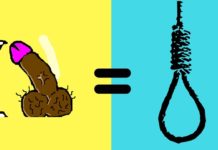The fantasy epic Game of Thrones is back this Sunday night, and it is sure to be chock full of intrigue, indiscretions and, of course, swords. The most sought-after blades in Westeros are made from Valyrian steel, forged using ancient magic. But could you make your own Valyrian steel sword using real-life chemistry? Reactions collaborated with cosplaying chemistry fanatic and material scientist Ryan Consell to see if we could blend metallurgy with Westerosi magic.
Ryan’s Blog –
Find us on all these places:
Subscribe!
Facebook!
Twitter!
Tumblr!
Kirk Zamieroski – Writer & Producer
Darcy Gentleman, PhD – Scientific Consultant
Noel Waghorn – Lead Writer/Producer
Adam Dylewski – Executive Producer
Music:
Soaring Action by Soundideas
source




















![[Book Review] The Blade Itself (The First Law Trilogy) by Joe Abercrombie](https://bendthekneegot.com/wp-content/uploads/2018/01/1516047103_maxresdefault-218x150.jpg)





















![JUSTICE LEAGUE “Casting The Flash” Promo [HD] Ezra Miller](https://bendthekneegot.com/wp-content/uploads/2017/10/1507246688_maxresdefault-100x70.jpg)
the ripples dont mean its made of cheap steals, today's Damascus is usually just two different carbon levels of high-quality steel
Valyrian Steel has the durability akin to S7 Shock steel. I saw a S7 steel cut deeply into a screw and not suffer any edge damage.
Personally I think Valyrian Steel might have carbon nanotubes in it.
How do you get the idea that "damascus" steel and the grains therein are from trying to form a good steel from two poor steels? If you're going to "inform" people at least get your facts straight!
The lines in the steel indicate the number of times the steel has been folded/stacked. The more folds or stacks the finer the lines/grain. Has nothing to do with poor steel! Two steels such as 1095 high carbon and 15n20 nickle alloy steel are both great steels. If they are forged together and folded the grains appear and as they are repeatedly layered the grain becomes finer and less pronounced until eventually they are imperceptible by naked eye. Get a clue!
There is a link to your "Valyian Steel" or what they made 500 years ago, but do not know how to make it today even had carbon nano tubes. https://www.pinterest.com/pin/472315079645034605/
woortz Steel. check it out.
Wootz steel in medieval India was made in a crucible, and had watery "ripple" patterns due to the presence of Vanadium, Molybdenum, silica and manganese. It was considered magical by medieval Europeans, because it was extremely light, flexible, durable, and held a razor sharp edge.
The Valyrians could have smelted their steel in a sealed crucible using dragonglass aka obsidian, which would have pulled impurities out of the steel. they could have had a deposit in Valyria as the Indians did that contained Iron ore naturally laced with the elements listed at the beginning. Dragonfire instead of coal fire could have been oxygen reducing, like an oxyacetylene gas forge.
For me it sounds like damascus steel
This video does a pretty good job exploring possible explanations, but still comes out with the answer "magic". Taking that into account, may be it's worth looking into George Martin's inspiration for writing about it. From the combination of super-characteristics in this alloy we can tell with a pretty good amount of certainty that he doesn't know much about steel, the fact that it has ripples (which likely suggests that it was folded) incites associations with either Damascus steel, Norse Ulfberhts, or Japanese folded steel katanas, all of which are surrounded by innumerable bullshit internet-facts, and are said to be near magical, inspiring Tom Cruise to cut through a rifle in Last Samurai (which, needless to say, is bullshit). Taking all of that in a bundle, I think it would be safe to say that George didn't really think it through quite as well as some of us would have liked him to, but rather chose to pander to people's ignorant concepts about steel that are based on misinformation, movies, and other books that don't follow through with research.
what about obsidian titanium composit, let's just say you powderize both materials and fuse them together in a zero oxygen environment like case welding
Iron Aluminium steel has a density about the same as titanium, its tough and I would think able to be pattern welded. Obsidian added to a the steel melt would bring silica and some other trace elements to the mix. Aluminium Steel and silica steel might be pattern welded to give the effects shown. Mind you this is just a thought exercise and not based on practical experience of these particular materials. Silica steel has some interesting magnetic effects.
Valyrian Steel might be adamantium or something radioactive.
damascus steel…people, are you that idiotic to see where it's based on? ripples, extremely durable and no modern counterpart
What if Valyrian were actually "Aliens!"
The elements you named actually back up a theory I had about the link between obsidian and Valyrian Steel. Silicon, Manganese, Carbon and Iron are all part of it. Chromium and Vanadium are typically used in stainless steel. Swirls of that type are also indicative of crucible steel such as Wootz Damascus. This steel composition was mined and smelted from a specific source in the east and brought west to the middle east most notably, and forged from the ingots provided. The swirls in the metal can also be brought to contrast with a simple acid bath. Vinegar can be used in softer metal, but it still takes an extreme amount if time. many modern day smiths use hydrochloric acid for a much quicker effect. I posit that Valyrian steel is such a crucible alloy, probably mostly Titanium accompanied by the other aforementioned elements. Check out Preston Jacobs channel for a more scientific outlook on the world of Planetos.
This is actually pattern welded steel also known as Damascus.It is a combination of two or more different types of steel,for example high carbon steel and a nickle steel like 1095 and 15N20.U can use also high speed steel because it is heat resistant to temperature up to 500 degrees of Celsius.And you can use a ferric chloride or vinegar or to etch the blade.
Valyrian steel was actually based of Damascus steel- which is why there is the distinct wavy pattern
Hey, we actually have a better contender for Valyrian steel now! There is has been a recently developed alloy which is a mix of Aluminium and carbon steel, which normally is too brittle to use. By adding manganese and nickel, however, inter-metallic bands form which make it strong. This stuff is fits the lore almost perfectly!
It's less dense than steel but has a higher strength to weight ratio and has similar hardness (Lighter+stronger swords), needs aluminium which cannot be made today without electricity and needs different working to forge (guessing would've Valyria used magic to deal with the aluminium), and while no one has reported it I'd imagine the inter metallic bands would give it a ripple appearance. To top it off since it contains aluminium it would be easier to cast like in the TV scene!
Amazing coincidence, considering this stuff has been reported recently. Just look up iron aluminium alloy to read about it.
Have you tried damascus steel
I always thought of valyrian steel as ASOIAF damascus steel. The ripple affect is one reason and how valyrian steel is super light and the metal damascus steel is made of is relatively lighter than other metals. Both are lost technologies that were called magical by outsiders (Europeans and the people of westeros) and even more so once the technology was lost. So valyrian steel is either a lighter version of damascus steel OR just a metal with a bunch of pretty swirls with magic as an answer for most questions
Damascus steel
So it turned out that is made with… obsydian?!
Valyrian Steel is indeed described as being spell-forged steel. Magic makes it lighter, sharper and more durable than even the best castle forged stuff. Because the secret to creating it was lost in the Doom of Valyria, blades became priceless and extremely rare.
It's confirmed there are about 200 blades in Westeros, though not all of them are swords. There are some knives and even axes are mentioned.
There are also rings and chain links for Maesters that choose to study Magic and the Higher Mysteries, though this study is disdained.
In Mr. Martin's own words: "We live in a world that has no Magic. My world does have Magic in it, so that makes it a bit different."
I always thought valyrian steel was based on myths about damascus steel. I didn' t think there was a real life counterpart to it,
George R.R. Martin just thought Valyrian Steel sounded cool and he was right. There's also references to something called Dragon Steel that could kill walkers. It hasn't been shown if these are different names for the same metal.
valyrian steel is its own element
+arwen evenstar
Meh, I'd rather have Dawn than any of the Valyrian Steel swords in A Song of Ice and Fire.
Ulfberht is probably what the sword was based on.
Yeah, when i was reading the books i figured Valyrian Steel was basically a magically produced form of Titanium.
Btw, so great to see someone actually get it right when it comes to pattern welding. So many times do you hear Katana fanboys go on and on about how folding the blade over and over made it stronger, which is just plain bullshit. All it did was evenly distribute the metallurgical flaws along the blade so no one point was any stronger or weaker than another. It was trying to make the best of a bad situation.
a lots wrong words in subtitle…
Steel? Always the same color??
Not with "Tempering"!
http://upload.wikimedia.org/wikipedia/commons/8/89/Tempering_standards_used_in_blacksmithing.JPG
Speaker voice is not a sports genre in the olympic games: 1. no need to talk that fast, 2. no need to scream!
во дебил..
How Does One Make Wildfire???
Daily Mail copied your video: http://www.dailymail.co.uk/sciencetech/article-3028848/Chemistry-Game-Thrones-Valyrian-steel-sword-Scientists-reveal-super-strong-weapon-made.html
An obvious view fishing attempt, but since the content is so exquisitely good, I don't care.
Valerian Steel appears to have been based on Damascus Steel (http://en.wikipedia.org/wiki/Damascus_steel). Interestingly, nobody knows exactly how Damascus Steel was made, although magic is probably out 🙂
ryan needs to get some sun.
The chemistry of Game of Thrones is indeed magical 🙂
Damascus steel tempered at around 800F (427C) to get it dark grey and approx hardness of 40-53 Rc depending on the quality of steel.
You guys do know that valaryian steel is a figment of imagination by a beard old guy? So much time and effort wasted on an imaginary thing..